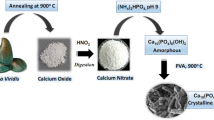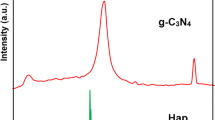Abstract
In recent years, the synthesis and application of green, cost-effective, and sustainable materials for uranium (VI) removal was significant to environmental protection. The ordered mesoporous carbon (CMK-3) supported different mass of hydroxyapatite materials (HAP@CMK-3) were facilely synthesized via hydrothermal method. The resultant materials were characterized by XRD, FT-IR, BET, SEM, TEM mapping, and XPS, and implemented for immobilizing U(VI). Not only the specific surface area of HAP (7.01 m2/g) was increased by the loading on CMK-3 (818.37 m2/g), but also the adsorption capacity of CMK-3 was increased by HAP modification. Impressively, HAP@CMK-3 exhibited highly adsorption capacity of U(VI) with the increase of HAP deposition and was capable of achieving fast reaction. Therein to, the specific surface area of HAP@CMK-3(2:1) was 253.68 m2/g, as well as the adsorption capacity was up to 1072 mg/g (fitted by Langmuir isotherm, at pH=3.0, 298 K) and the adsorption process was completed in 30 min (followed by pseudo-second-order kinetic). The adsorption mechanisms of U(VI) on HAP@CMK-3 involved electrostatic forces, ionic interactions, and chemical complexation. This work offered new avenues to address the limitations of cost and less secondary pollution for the removal of U(IV) from wastewater.








Similar content being viewed by others
Data availability
Yes.
References
Ahmed W, Nunez-Delgado A, Mehmood S, Ali S, Qaswar M, Shakoor A, Chen DY (2021) Highly efficient uranium (VI) capture from aqueous solution by means of a hydroxyapatite-biochar nanocomposite: adsorption behavior and mechanism. Environ Res 201:111518
Chen L, Zhang K-S, He J-Y, Xu W-H, Huang X-J, Liu J-H (2016) Enhanced fluoride removal from water by sulfate-doped hydroxyapatite hierarchical hollow microspheres. Chem Eng J 285:616–624
El-Maghrabi HH, Younes AA, Salem AR, Rabie K, El-Shereafy ES (2019) Magnetically modified hydroxyapatite nanoparticles for the removal of uranium (VI): Preparation, characterization and adsorption optimization. J Hazard Mater 378:120703
Ezzeddine Z, Batonneau-Gener I, Pouilloux Y, Hamad H, Saad Z (2019) The applicability of as synthesized mesoporous carbon CMK-3 as a heavy metals adsorbent: application to real water samples. Energy Sources, Part A: Recov Util Environ Effects 43:1675–1690
Foster RI, Kim KW, Oh MK, Lee KY (2019) Effective removal of uranium via phosphate addition for the treatment of uranium laden process effluents. Water Res 158:82–93
Guo Y, Gong Z, Li C, Gao B, Li P, Wang X, Zhang B, Li X (2020) Efficient removal of uranium (VI) by 3D hierarchical Mg/Fe-LDH supported nanoscale hydroxyapatite: a synthetic experimental and mechanism studies. Chem Eng J 392:123682
Hu R, Xiao J, Wang T, Chen G, Chen L, Tian X (2020) Engineering of phosphate-functionalized biochars with highly developed surface area and porosity for efficient and selective extraction of uranium. Chem Eng J 379:122388
Hu B, Wang H, Liu R, Qiu M (2021) Highly efficient U(VI) capture by amidoxime/carbon nitride composites: evidence of EXAFS and modeling. Chemosphere 274:129743
Jeong Y, Cui M, Choi J, Lee Y, Kim J, Son Y, Khim J (2020) Development of modified mesoporous carbon (CMK-3) for improved adsorption of bisphenol-A. Chemosphere 238:124559
Kong L, Ruan Y, Zheng Q, Su M, Diao Z, Chen D, Hou L, Chang X, Shih K (2020) Uranium extraction using hydroxyapatite recovered from phosphorus containing wastewater. J Hazard Mater 382:120784
Kong A, Sun Y, Peng M, Gu H, Fu Y, Zhang J, Li W (2021) Amino-functionalized MXenes for efficient removal of Cr(VI). Colloids Surf A Physicochem Eng Asp 617:126388
Lei J, Liu H, Yuan C, Chen Q, Liu J-A, Wen F, Jiang X, Deng W, Cui X, Duan T, Zhu W, He R (2021) Enhanced photoreduction of U(VI) on WO3 nanosheets by oxygen defect engineering. Chem Eng J 416:129164
Li H, Zhai F, Gui D, Wang X, Wu C, Zhang D, Dai X, Deng H, Su X, Diwu J, Lin Z, Chai Z, Wang S (2019) Powerful uranium extraction strategy with combined ligand complexation and photocatalytic reduction by postsynthetically modified photoactive metal-organic frameworks. Appl Catal B Environ 254:47–54
Liu Y, Li Q, Cao X, Wang Y, Jiang X, Li M, Hua M, Zhang Z (2013) Removal of uranium(VI) from aqueous solutions by CMK-3 and its polymer composite. Appl Surf Sci 285:258–266
Liu J, Zhao C, Zhang Z, Liao J, Liu Y, Cao X, Yang J, Yang Y, Liu N (2016) Fluorine effects on U(VI) sorption by hydroxyapatite. Chem Eng J 288:505–515
Liu X, Liu Y, Wang Y, Yuan D, Liu J, Chew JW (2021) Preparation of porous carbon materials by polyphosphazene as precursor for sorption of U(VI). Colloid Interface Sci Commun 41:100387
Lu S, Zhu K, Guo H, Wang H, Zhang N, Alsaedi A, Hayat T, Li Y, Sun Y (2019) The influence of humic acid on U(VI) sequestration by calcium titanate. Chem Eng J 368:598–605
Lu L, Zhang Y, Yuan Z, Xu J, Li M, Wu Y, Wang L, Huang S, Rao Y (2021) Easily fabricated HARCP/HAp photocatalyst for efficient and fast removal of tetracycline under natural sunlight. Chem Eng J 412:128620
Potgieter M, van der Spoel Badenhorst WD, Barry JC, van der Westhuizen DJ, Krieg HM (2020) Feasibility of electro-reduction of U(VI) in oxalic acid using an electrolytic CEM-separated cell. J Radioanal Nucl Chem 326:1505–1510
Qiu M, Liu Z, Wang S, Hu B (2021) The photocatalytic reduction of U(VI) into U(IV) by ZIF-8/g-C3N4 composites at visible light. Environ Res 196:110349
Saha S, Basu H, Rout S, Pimple MV, Singhal RK (2020) Nano-hydroxyapatite coated activated carbon impregnated alginate: a new hybrid sorbent for uranium removal from potable water. J Environ Chem Eng 8:103999
Shi Q, Su M, Yuvaraja G, Tang J, Kong L, Chen D (2020) Development of highly efficient bundle-like hydroxyapatite towards abatement of aqueous U(VI) ions: Mechanism and economic assessment. J Hazard Mater 394:122550
Su M, Tsang DCW, Ren X, Shi Q, Tang J, Zhang H, Kong L, Hou L, Song G, Chen D (2019) Removal of U(VI) from nuclear mining effluent by porous hydroxyapatite: evaluation on characteristics, mechanisms and performance. Environ Pollut 254:112891
Sun Y, Zhang H, Yuan N, Ge Y, Dai Y, Yang Z, Lu L (2021) Phosphorylated biomass-derived porous carbon material for efficient removal of U(VI) in wastewater. J Hazard Mater 413:125282
Szenknect S, Mesbah A, Descostes M, Maihatchi-Ahamed A, Bonato L, Massonnet M, Ziouane Y, Vors E, Vercouter T, Clavier N, Lautru J, Dacheux N (2020) Uranium removal from mining water using Cu substituted hydroxyapatite. J Hazard Mater 392:122501
Taha MH (2021) Sorption of U(VI), Mn (II), Cu(II), Zn(II), and Cd(II) from multi-component phosphoric acid solutions using MARATHON C resin. Environ Sci Pollut Res Int 28:12475–12489
Venkateswara Rao C, Rout A, Boda A, Musharaf Ali S, Venkatesan KA (2021) Anion assisted extraction of U(VI) in alkylammonium ionic liquid: experimental and DFT studies. Sep Purif Technol 261:118275
Wang Y-Q, Zhang Z-B, Liu Y-H, Cao X-H, Liu Y-T, Li Q (2012) Adsorption of U(VI) from aqueous solution by the carboxyl-mesoporous carbon. Chem Eng J 198-199:246–253
Wang H, Lv Z, Wang YN, Sun Y, Tsang YF (2021a) Recycling of biogenic hydroxyapatite (HAP) for cleaning of lead from wastewater: performance and mechanism. Environ Sci Pollut Res Int 28:29509–29520
Wang Y, Hu X, Liu Y, Li Y, Lan T, Wang C, Liu Y, Yuan D, Cao X, He H, Zhou L, Liu Z, Chew JW (2021b) Assembly of three-dimensional ultralight poly(amidoxime)/graphene oxide nanoribbons aerogel for efficient removal of uranium(VI) from water samples. Sci Total Environ 765:142686
Xue G, Yurun F, Li M, Dezhi G, Jie J, Jincheng Y, Haibin S, Hongyu G, Yujun Z (2017) Phosphoryl functionalized mesoporous silica for uranium adsorption. Appl Surf Sci 402:53–60
Yin L, Hu Y, Ma R, Wen T, Wang X, Hu B, Yu Z, Hayat T, Alsaedi A, Wang X (2019) Smart construction of mesoporous carbon templated hierarchical Mg-Al and Ni-Al layered double hydroxides for remarkably enhanced U(VI) management. Chem Eng J 359:1550–1562
You Z, Zhang N, Guan Q, Xing Y, Bai F, Sun L (2019) High Sorption capacity of u(vi) by cof-based material doping hydroxyapatite microspheres: kinetic, equilibrium and mechanism investigation. J Inorg Organomet Polym Mater 30:1966–1979
Zeng D, Dai Y, Zhang Z, Wang Y, Cao X, Liu Y (2020) Magnetic solid-phase extraction of U(VI) in aqueous solution by Fe3O4@hydroxyapatite. J Radioanal Nucl Chem 324:1329–1337
Zhang C, Li X, Chen Z, Wen T, Huang S, Hayat T, Alsaedi A, Wang X (2017a) Synthesis of ordered mesoporous carbonaceous materials and their highly efficient capture of uranium from solutions. SCIENCE CHINA Chem 61:281–293
Zhang D, Liu L, Aihaiti T, Xu X, Ding S (2017b) MoS2 Nanosheets Grown on CMK-3 with Enhanced Sodium Storage Properties. ChemistrySelect 2:5283–5287
Zhang Z, Dong Z, Wang X, Ying D, Niu F, Cao X, Wang Y, Hua R, Liu Y, Wang X (2018) Ordered mesoporous polymer-carbon composites containing amidoxime groups for uranium removal from aqueous solutions. Chem Eng J 341:208–217
Zhao B, Yuan L, Wang Y, Duan T, Shi W (2021) Carboxylated UiO-66 Tailored for U(VI) and Eu(III) Trapping: from batch adsorption to dynamic column separation. ACS Appl Mater Interfaces 13:16300–16308
Zheng N, Yin L, Su M, Liu Z, Tsang DCW, Chen D (2020) Synthesis of shape and structure-dependent hydroxyapatite nanostructures as a superior adsorbent for removal of U(VI). Chem Eng J 384:123262
Zhong X, Lu Z, Liang W, Guo X, Hu B (2020) The fabrication of 3D hierarchical flower-like δ-MnO2@COF nanocomposites for the efficient and ultra-fast removal of UO22+ ions from aqueous solution. Environ Sci: Nano 7:3303–3317
Zhong X, Liang W, Wang H, Xue C, Hu B (2021a) Aluminum-based metal-organic frameworks (CAU-1) highly efficient UO22+ and TcO4- ions immobilization from aqueous solution. J Hazard Mater 407:124729
Zhong X, Liu Y, Liang W, Zhu Y, Hu B (2021b) Construction of core-shell MOFs@COF Hybrids as a platform for the removal of UO22+ and Eu3+ Ions from solution. ACS Appl Mater Interfaces 13:13883–13895
Zhou Y, Zhang X, Zhang H, Xiong K, Chen J, Shen Y, Tang Y, Li X (2020) On the removal of the Cr(VI) in water by an ordered mesoporous carbon material: kinetic and isotherm studies. Water Air Soil Pollut 231:78–88
Zhou R, Zhang Z, Cheng Z, Dai Y, Liu Y, Wang Y, Xie Y, Zhang Z, Cao X, Liu Y (2021) Selective adsorption of uranium from aqueous solution by mesoporous polymer-carbon composites containing phosphate groups. Environ Nanotechnol Monit Manag 15:100441
Funding
Financial support from the scientific research start-up fund of Shaoxing University (13011001002/096).
Author information
Authors and Affiliations
Contributions
Ming Ma: writing-original draft; formal analysis; validation; investigation; resource; funding acquisition. Hao Deng: formal analysis; validation; investigation; resources. Zhenyu Ren: validation; investigation; resources. Xin Zhong: conceptualization; methodology; supervision; visualization.
Corresponding author
Ethics declarations
Ethical statement and consent to participate
Not applicable.
Consent for publication
Yes.
Competing interests
The authors declare that they have no known competing financial interests or personal relationships that could have appeared to influence the work reported in this paper.
Additional information
Responsible Editor: Angeles Blanco
Publisher’s note
Springer Nature remains neutral with regard to jurisdictional claims in published maps and institutional affiliations.
Supplementary information
ESM 1
(DOCX 662 kb)
Rights and permissions
About this article
Cite this article
Ma, M., Deng, H., Ren, Z. et al. High-speed and efficient removal of uranium (VI) from aqueous solution by hydroxyapatite-modified ordered mesoporous carbon (CMK-3). Environ Sci Pollut Res 29, 78989–79001 (2022). https://doi.org/10.1007/s11356-022-21351-2
Received:
Accepted:
Published:
Issue Date:
DOI: https://doi.org/10.1007/s11356-022-21351-2




